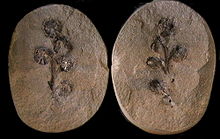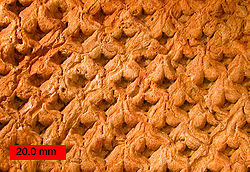Paleobotany

Crossotheca hughesiana Kidston, Middle Pennsylvanian, Coseley, near Dudley, UK. A lyginopteridalean pollen organ preserved as an authigenic mineralisation. Specimen in Sedgwick Museum, Cambridge, UK. Photo by Verisimilus.
Paleobotany, also spelled as palaeobotany (from the Greek words paleon = old and "botany", study of plants), is the branch of paleontology or paleobiology dealing with the recovery and
identification of plant
remains from geological contexts, and their use for the biological
reconstruction of past environments (paleogeography), and both the evolutionary history of plants, with a bearing upon
the evolution of life in general. A synonym is
paleophytology. Paleobotany includes the study of
terrestrial plant fossils, as well as the study of prehistoric
marine photoautotrophs, such as photosynthetic algae, seaweeds or kelp. A closely-related field is palynology, which is the study of fossilized
and extant spores and pollen.
Paleobotany is important in the reconstruction of ancient ecological systems and climate, known as paleoecology and paleoclimatology respectively; and is fundamental to
the study of green plant development and evolution. Paleobotany has also become important to
the field of archaeology, primarily for the use of phytoliths in relative dating and in paleoethnobotany,
Overview of
the paleobotanical record
Macroscopic remains of true vascular plants are first found in the fossil record during the Silurian Period of the Paleozoic era. Some dispersed, fragmentary fossils of
disputed affinity, primarily spores and cuticles, have been found in rocks from the Ordovician Period in Oman, and are thought to derive from liverwort- or moss-grade fossil plants (Wellman et al., 2003).
An important early land plant fossil locality is the Rhynie
Chert, found outside the village of Rhynie in Scotland. The Rhynie chert is an Early Devonian sinter (hot spring) deposit composed primarily of silica. It is exceptional due to its preservation of
several different clades of plants, from mosses and lycopods to more unusual, problematic forms. Many
fossil animals, including arthropods and arachnids, are also found in the Rhynie Chert, and it
offers a unique window on the history of early terrestrial life.
Plant-derived macrofossils become abundant in the Late Devonian and include tree trunks, fronds, and roots. The earliest tree is Archaeopteris, which bears simple, fern-like leaves spirally arranged on branches atop a conifer-like
trunk (Meyer-Berthaud et al., 1999).
Widespread coal swamp deposits across North America and Europe
during the Carboniferous Period contain a wealth of fossils
containing arborescent lycopods up to 30 meters tall, abundant
seed plants, such as conifers and seed ferns, and countless smaller, herbaceous
plants.
Angiosperms (flowering plants) evolved during the Mesozoic, and flowering plant pollen and leaves first
appear during the Early Cretaceous, approximately 130 million years ago.
Fossil groups of
plants
Some plants have remained remarkedly unchanged throughout earth's geological
time scale. Early ferns had developed by the Mississippian, conifers by the Pennsylvanian. Some plants of prehistory are the
same ones around today and are thus living fossils, such as Ginkgo
biloba and Sciadopitys verticillata. Other plants have
changed radically, or have gone extinct entirely.
Examples of prehistoric plants are:
Araucaria mirabilis Archaeopteris Calamites Glossopteris Hymenaea protera Nelumbo aureavallis Protosalvinia Palaeoraphe Trochodendron nastae Dillhoffia Peltandra primaeva Pachypteris
identification of plant
remains from geological contexts, and their use for the biological
reconstruction of past environments (paleogeography), and both the evolutionary history of plants, with a bearing upon
the evolution of life in general. A synonym is
paleophytology. Paleobotany includes the study of
terrestrial plant fossils, as well as the study of prehistoric
marine photoautotrophs, such as photosynthetic algae, seaweeds or kelp. A closely-related field is palynology, which is the study of fossilized
and extant spores and pollen.
Paleobotany is important in the reconstruction of ancient ecological systems and climate, known as paleoecology and paleoclimatology respectively; and is fundamental to
the study of green plant development and evolution. Paleobotany has also become important to
the field of archaeology, primarily for the use of phytoliths in relative dating and in paleoethnobotany,
Overview of
the paleobotanical record
Macroscopic remains of true vascular plants are first found in the fossil record during the Silurian Period of the Paleozoic era. Some dispersed, fragmentary fossils of
disputed affinity, primarily spores and cuticles, have been found in rocks from the Ordovician Period in Oman, and are thought to derive from liverwort- or moss-grade fossil plants (Wellman et al., 2003).
An important early land plant fossil locality is the Rhynie
Chert, found outside the village of Rhynie in Scotland. The Rhynie chert is an Early Devonian sinter (hot spring) deposit composed primarily of silica. It is exceptional due to its preservation of
several different clades of plants, from mosses and lycopods to more unusual, problematic forms. Many
fossil animals, including arthropods and arachnids, are also found in the Rhynie Chert, and it
offers a unique window on the history of early terrestrial life.
Plant-derived macrofossils become abundant in the Late Devonian and include tree trunks, fronds, and roots. The earliest tree is Archaeopteris, which bears simple, fern-like leaves spirally arranged on branches atop a conifer-like
trunk (Meyer-Berthaud et al., 1999).
Widespread coal swamp deposits across North America and Europe
during the Carboniferous Period contain a wealth of fossils
containing arborescent lycopods up to 30 meters tall, abundant
seed plants, such as conifers and seed ferns, and countless smaller, herbaceous
plants.
Angiosperms (flowering plants) evolved during the Mesozoic, and flowering plant pollen and leaves first
appear during the Early Cretaceous, approximately 130 million years ago.
Fossil groups of
plants
Some plants have remained remarkedly unchanged throughout earth's geological
time scale. Early ferns had developed by the Mississippian, conifers by the Pennsylvanian. Some plants of prehistory are the
same ones around today and are thus living fossils, such as Ginkgo
biloba and Sciadopitys verticillata. Other plants have
changed radically, or have gone extinct entirely.
Examples of prehistoric plants are:
Stigmaria

Stigmaria, a common fossil tree root. Upper Carboniferous of northeastern Ohio.
Lepidodendron

